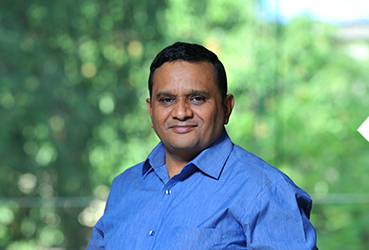Chandrakant Kumbhani - GM-Community Development at ACF is a seasoned professional in Rural Development with more than 20 years of experience under his belt. At ACF, Chandrakant oversees community development programs for water resource management, women, agriculture, health, & education across all locations. Thrive caught up with Chandrakant to understand the nuances of 'enabling people' to enable prosperity.
Thrive: Enabling People & communities seems to run in the DNA of ACF's approach towards rural development. Is that an outcome of ACF's years of experience with rural communities?
Chandrakant: Enabling communities is a long-term process & requires a lot of patience. You need to be with the community to understand their needs & build apt interventions. Through its multifarious programs, ACF has always focused on Enabling People to strengthen livelihoods & enable prosperity. It is an understanding that has existed since the beginning. We have always known that enabling people is the key to them achieving prosperity.
Thrive: What do you think is the fundamental difference in enabling people versus doing work for them?
Chandrakant: Doing is a very tactical approach towards rural development primarily centred around demand of the communities and more of a top down approach. For example: If a certain region has a water issue, I might build a check dam in the region and my work is done. On the other hand, when one is 'enabling people', the approach includes understanding the community's needs with water, potential solutions that can increase water availability, & technical feasibility. In this entire process, the community is involved at every step of the planning & implementation. The community owns the project and takes up its management both pre and post implementation of the solution.
Enabling people is a strategic process which ensures that the solution is sustainable. It involves understanding community needs, ground realities, educating people, designing solutions considering perspectives of the community, implementing the solution with people & enabling people to manage & maintain the solution going forward. In short, it is the participation of the organisation in a people's program rather than people's participation in organisation's program.
Thrive: What is the approach that ACF employs in enabling a community?
Chandrakant: Whenever ACF brings any intervention to the community, it looks at building people's institutions first; to ensure sustainability right from the beginning. As a developmental organisation, the participation of the community is a clear mandate. The approach is always bottom up which starts with identification of challenges that the community faces. Only after gaining a perspective from the community, science & technology solutions are brought in to solve the challenges. In the context of implementation also, ease of understanding & use by the community is a lens that ACF would use to gauge the feasibility of the solution. Take agriculture for example; One can just go and distribute a few seeds of new varieties of crops or saplings to farmers and feel satisfied about the work done. ACF's approach, on the other hand, would start with understanding the needs of the farmers by learning their current practices and then identify gaps vis-Ã -vis recommended practices of a crop. Once gaps are identified, education through training and demonstration is initiated, so farmers can understand, realise, and adopt better crop management practices, resulting in better yield and income.
Also, the approach focuses on the long-term sustainability of any solution versus just doling out subsidies or providing inputs for free. Many of ACF's interventions have people from the community leading the work in their villages; be it the cadre of rural women 'Sakhis' in the health program or the Pashu Swasthya Sevikas in Veterinary Health programs. These community workers act as a critical link between ACF & the community for various interventions.
Thrive: What are the challenges that you face in the context of enabling communities?
Chandrakant: ACF always works with a long-term perspective in mind. Wherever we are present, we have broadly worked for 10-15 years & hence, trust is inherent w.r.t any intervention we bring to the community. Our biggest challenge, usually, is changing notions of the community in terms of expectations. People are used to being given freebies, subsidies and have material expectations from any organisation that does developmental work. The mindset of subsidy is so deeply embedded that for any intervention, the expectation is that the organisation will bear most of the costs involved.
ACF also works in resource poor geographies which implies that in the initial phase, community challenges are many & designing a holistic intervention with a set of common goals takes some time. For example: with the Better Cotton Initiative program that ACF manages, we took 4 years to reach 10000 farmers across 4 locations but in the next 5 years now we reached 170,000 farmers. The key point is ensuring that people can see, know, or understand the effects of enablement on their livelihoods. Once this is established, people will do what is beneficial to them and scale can be achieved.
Thrive: What is the typical time frame that it takes to enable communities in the context of an area of intervention?
Chandrakant: Based on my experience, any developmental program should look at least 8-10 years. One must also be mindful that the nature of issues will keep shifting. For example: ACF started working on health in Chandrapur, Maharashtra, almost 20 years back with the 'Mother & Child health' project which was a dire need in the community. The program was scaled, and indicators were improved. However, today, the prevalence of Non-Communicable Diseases (NCD) is making us shift focus to improving healthcare for such conditions. In Kodinar, Gujarat, ACF saw the need to empower women in the community & ACF team members would be out on the field daily, talking to & convincing women to form Self Help Groups. Today, a women's federation, supported by ACF has taken that role while ACF provides necessary training & guidance. As you can see, the nature of engagement & the roles keeps changing based on the needs of the community.
Thrive: How does ACF look at funding interventions in the context of 'Enabling People'
Chandrakant: While both ACF as well as the community participate in investing in the intervention, if we see opportunity for any of our existing or potential partners to invest, we do reach out to them. These could include the Government & allied bodies, CSR organizations & other national & international funding agencies. We know the potential project opportunities in each of our locations and that helps us in reaching out to partners with specific propositions. Our expertise in implementation coupled with investments from like-minded partners helps us scale interventions. In practice, ACF has been working this way ever since inception in the early nineties. Our initial years saw many joint initiatives with the government & associated bodies.
Thrive: Can you cite 2 shining stars from ACF's work in enabling people?
Chandrakant: ACF's work in Kodinar, Gujarat for water - be it drinking water or ground water recharge for irrigation by harvesting water using dams to water use efficiency utilizing micro irrigation has been exemplary. The sheer scale of the intervention in the region which is home to over 225,000 people has been enormous. By enabling people, we have been able to bring prosperity and offer sustainable livelihoods to many.
Another example would be ACF's skilling centres. Across 33 locations, each skilling centre (SEDI) offers 42 National Skill Development Corporation certified courses in 8 sectors linked to local. employment such as welding, nursing, retail, banking & BPO operations. Each course lasting 3-6 months is designed to equip the youth in these remote, rural locations with necessary skills and confidence to earn a livelihood. Each of the youth enrolled at SEDI is equipped with both hard skills and soft skills, and with the support of dedicated placement teams, can be gainfully employed.
Another feather in our cap is the partnership with Better Cotton Initiative that enables small holding farmers to be prosperous and ensures that cotton farming remains sustainable. The focus on outreach, training, exposure, and demonstration cannot be emphasised enough. Enabling the farmers with knowledge and information on BCI principles and criteria helps them to implement and imbibe better practices in cotton cultivation. This results in cotton growing becoming sustainable, not only for them but for the environment at large, and the sector itself.








0 Comment